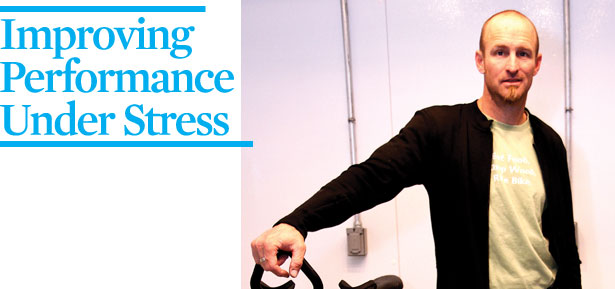
In an enclosed chamber in his lab at the University of Montana, Brent Ruby can alter conditions such as temperature, humidity, and altitude to monitor body's response to environmental stressors.
Photo by Rebecca Stumpf
Brent Ruby '89 positions a 4-inch needle above his quadriceps. When the needle, slightly narrower in diameter than a standard drinking straw, is in position, he plunges it into his thigh and extracts his own muscle tissue for scientific study of how sustained fatigue affects the human body. During the 2006 Ironman World Championship, he not only competed but also had muscle samples extracted from his quadriceps before and after the event.
It is that degree of devotion to understanding human endurance under extremes of heat, cold, and humidity that is aiding the U.S. Forest Service and the Department of Defense to ensure safety and stamina under tough working conditions.
Director of the Montana Center for Work Physiology and Exercise Metabolism at the University of Montana, Ruby calls wildland firefighters and soldiers "elite occupational athletes."
"We help them develop novel feeding and drinking strategies to enhance their protection and performance on the line," he says.
Ruby found in feeding studies with wildfire suppression crews that firefighters can shed up to 8 liters of water in 24 hours. At the same time they burn 4,500–6,500 calories, more than double the daily calories expended by the average man. Because crew members demonstrated an increased work rate when they were fed consistently throughout the workday, the U.S. Army Institute for Environmental Medicine developed the First Strike Ration. The First Strike Ration provides frequent, high-quality foods that enable eating on the go an average of four or five times per shift.
"With an increased work output comes increased vigilance on the fire line, which in turn increases the likelihood of a safer work shift," says Brent Ruby, who studies fitness in wilderness firefighters.
"The results were increased work output," says Ruby, whose research into human endurance centers on what he calls "the big four" variables: saliva, urine, blood, and muscle. "With an increased work output comes increased vigilance on the fire line, which in turn increases the likelihood of a safer work shift."
Military special operations forces also receive a great deal of Ruby's attention. Typically, special-operations recruits drop out of training programs in high numbers. Ruby and his research team study the stamina and stress required to do that difficult job and seek ways to keep recruits in training and to meet their unique needs under combat conditions. It is no easy task. Members of special-operations forces may carry loads as heavy as 170 pounds into action in desert temperatures that can reach 120 degrees.
"The Montana Center is unique in that it enables advanced study in and outside the laboratory," says Ruby, an avid cyclist and triathlete. "Whereas the process of research in the hands of the typical scientist might end with the publication or presentation of data in disciplinary journals and research meetings, we try and bring our data to life."
